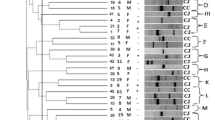Abstract
During the period 1987 to 1991 a retrospective study was performed to determine the resistance of thermotolerantCampylobacter species isolated from feces to erythromycin and fluoroquinolones. Of the 672 strains studied, 614 (91.3 %) were identified asCampylobacter jejuni and 58 (8.7 %) asCampylobacter coli. During the study period the rate of resistance ofCampylobacter jejuni to erythromycin remained relatively stable (0.9–3.5 %), while resistance ofCampylobacter coli to erythromycin emerged later (1989) with much higher rates (14.8–33 %). Overall, 11.8 % and 10.7 % ofCampylobacter jejuni strains isolated after 1987 were resistant to nalidixic acid and ciprofloxacin respectively, resistance increasing from 2.3 % in 1988 to 32 % in 1991. In 1991 the first strains ofCampylobacter coli with resistance to these fluoroquinolones were detected (rates 29 % and 26 % respectively). Of the strains resistant to nalidixic acid, only 10.9 % were susceptible to ciprofloxacin.
Similar content being viewed by others
References
Skirrow MB: A demographic survey ofCampylobacter, Salmonella andShigella infections in England. Epidemiology and Infection 1987, 99: 647–657.
Penner JL: The genusCampylobacter: a decade of progress. Clinical Microbiology Reviews 1988, 1: 157–172.
DeWitt TG: Acute diarrhea in children. Pediatric Reviews 1988, 11: 13–34.
Robins-Browne RM, Mackenjee MK, Bodasing MN, Coovadia HM: Treatment ofCampylobacter-associated enteritis with erythromycin. American Journal of Diseases of Children 1983, 137: 282–285.
Tylor DE, Blaser MJ, Echeverria P, Pitarangasi C, Bodhidatta L, Wang WL: Erythromycin-resistantCampylobacter infections in Thailand. Antimicrobial Agents and Chemotherapy 1987, 31: 438–442.
Penner JL:Campylobacter, Helicobacter and related spiral bacteria. In: Balows A, Hausler WJ, Hermann KL, Isenberg HD, Shadomy HJ (ed): Manual of clinical microbiology. American Society for Microbiology, Washington, DC, 1991, p. 402–409.
Endtz HP, Gijs JR, van Klingeren B, Jansen WH, van der Reyden T, Mouton RP: Quinolone resistance in campylobacter isolated from man and poultry following the introduction of fluoroquinolones in veterinary medicine. Journal of Antimicrobial Chemotherapy 1991, 27: 199–208.
Brunton WA, Wilson AM, Macrae RM: Erythromycin-resistantCampylobacter. Lancet 1978, ii: 1385.
Taylor DE, Chang N, Garner RS, Sherburne R, Mueller L: Incidence of antibiotic resistance and characterization of plasmids inCampylobacter jejuni strains isolated from clinical sources in Alberta, Canada. Canadian Journal of Microbiology 1986, 32: 28–32.
Reina J, Alomar P: Fluoroquinolone resistance in thermophilicCampylobacter spp. isolated from stools of Spanish patients. Lancet 1990, 336: 186.
Reina J: Incremento progresivo de la resistencia a ciprofloxacino y eritromicina en el grupo de las campilobacterias termotolerantes aisladas en heces. Revista Española de Microbiologia Clinica 1991, 6: 305–306.
Rautelin H, Renkonen OV, Kosunen TU: Emergence of fluoroquinolone resistance inCampylobacter jejuni andCampylobacter coli in subjects from Finland. Antimicrobial Agents and Chemotherapy 1991, 35: 2065–2069.
Endtz HP, Mouton RP, van der Reyden T, Ruijs GJ, Biever M: Fluoroquinolone resistance inCampylobacter spp. isolated from human stools and poultry products. Lancet 1990, 335: 787.
Reina J, Blanco I, Catala A, Alomar P: Aislamiento deCampylobacter jejuni resistente al acido nalidixico. Enfermedades Infecciosas y Microbiologia Clinica 1989, 7: 288–289.
Reina J, Parras F, Alomar P: Deteccion de cepas deCampylobacter jejuni resistentes a las quinolonas: resistencia post-tratamiento. Revista Española de Microbiologia Clinica 1989, 4: 318.
Altwegg M, Burness A, Zollinger-Iten J, Penner JL: Problems in identification ofCampylobacter jejuni associated with acquisition of resistance to nalidixic acid. Journal of Clinical Microbiology 1987, 25: 1807–1808.
Adler-Mosca H, Lüthy-Hottenstein J, Martinetti G, Burnens A, Altwegg M: Development of resistance to quinolones in five patients with campylobacteriosis treated with norfloxacin or ciprofloxacin. European Journal of Clinical Microbiology & Infectious Diseases 1991, 10: 953–957.
Douidar SM, Snodgrass WR: Potential role of fluoroquinolones in pediatric infections. Reviews of Infectious Diseases 1989, 11: 878–889.
Author information
Authors and Affiliations
Rights and permissions
About this article
Cite this article
Reina, J., Borrell, N. & Serra, A. Emergence of resistance to erythromycin and fluoroquinolones in thermotolerantCampylobacter strains isolated from feces 1987–1991. Eur. J. Clin. Microbiol. Infect. Dis. 11, 1163–1166 (1992). https://doi.org/10.1007/BF01961137
Issue Date:
DOI: https://doi.org/10.1007/BF01961137




